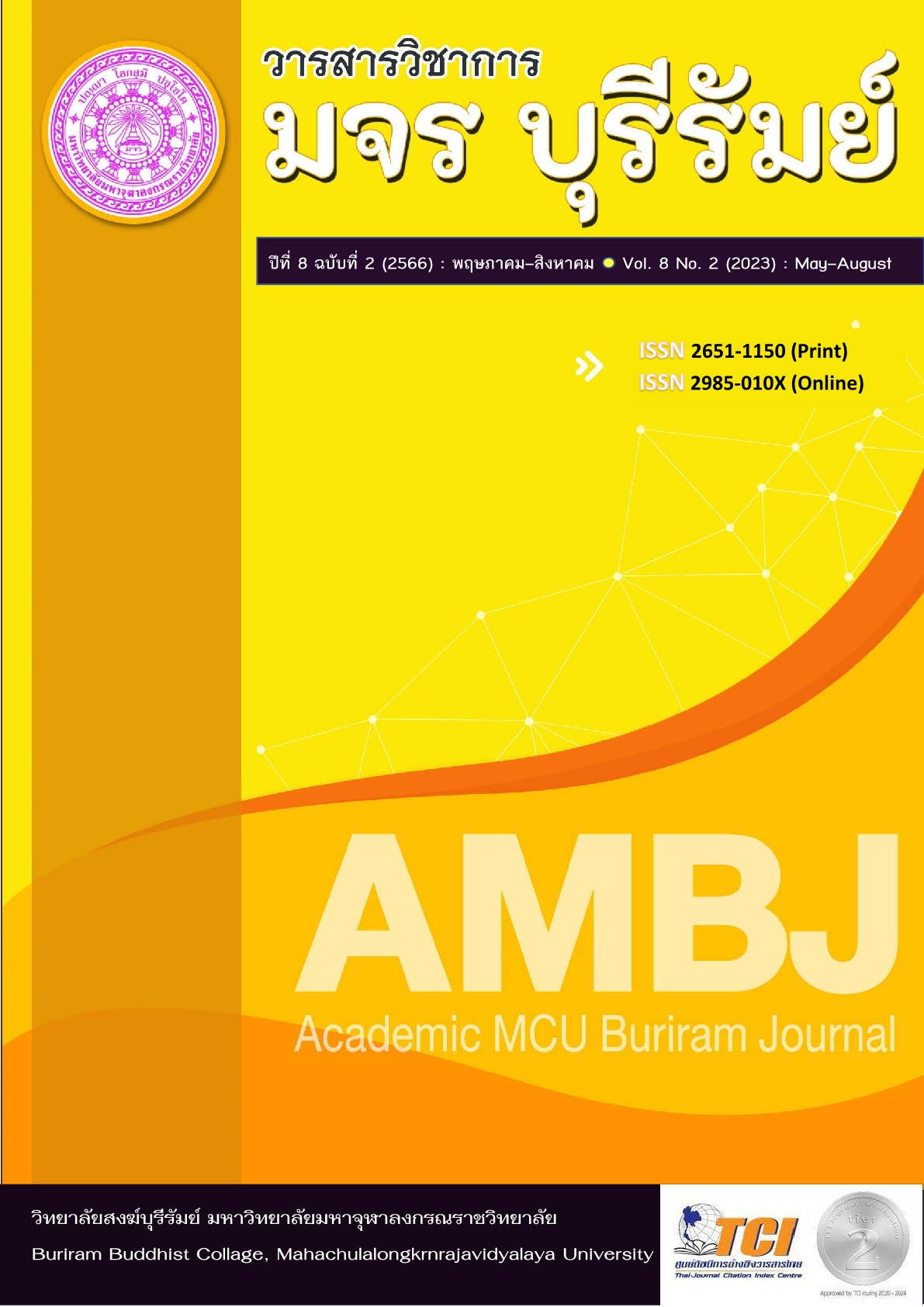A Critical Study of Essenes of Dhamma in Majjhimanikaya Mulapannaska
Keywords:
Essenes of Dhamma, Majjhimanikaya, MulapannaskaAbstract
The purpose of this research were: 1) to study the meaning, structure, content and nature of the sutras in the Middle Nikaya Mulpananasaka Mulpanasaka and 3) to apply the core Dharma from the Middle Nikaya Mulpanasaka for the development of life and society. The research is qualitative research, which focuses on documentary research by studying information from Tripitaka, commentary, sub-commentary,sub-sub-commentary, academic works, books, textbooks, articles, documents and related researches. The data were analyzed and the research results were presented in the form of a descriptive analysis according to the research objectives.
The research result found that:
1. The Majjhima Nikaya is the second of the five sects, containing medium-sized sutras.It is contained in the 12th, 13th, and 14th volumes of the Tripitaka, it is divided into 3 Pannasaka contents, consisting of the Middle Nikaya Mulpannask, Volume 12, the Medium Nikaya, Volume 13 Upiri Pannasaka, Volume 14. A total of 3 Pannasaka is containing 152 sutras, with the structure of dividing the content into Pannasaka, paragraph and Sutra. The Majjhimanikaya Mulpanasaka sutras are divided into 5 paragraphs, each of 10 sutras, consisting of the Mulapariyavagga, Sihanadavagga, Opammamvagga, Mahayamakavagga, and Culayamakavagga.The style of the sutra is a mixture of prose and poetry.
2. Majjhimanikaya Mulpanasaka Volume 12 contains 50 sutras, divided into 5 paragraphs, 10 sutras each.A first paragraph that deals with the cause of the Dharma. The second paragraph is called Sihanadavagga.The third paragraph is called Opammavagga. The fourth Paragraph is called Mahayamakavagga, and the fifth paragraph is called Culayamakavagga. The essence of Dharma that appears is, for example, the root cause of Dharma, cautiousness of all kinds fear and fear person without passion small fortune telling with great color radiance, heaps of sorrows, Dharma that is satisfying like sweets two-way thinking, the doctrine likened to a saw, comparison with venomous snakes, comparison with anthills, the analogy with the 7-turn vehicle, The analogy with the cowherd, the end of lust knowledge-based interaction meditation, concerning monks who investigate.
3. The application of the essence of the Dharma from the Middle Nikaya Mulpanasaka for the development of life and society, Essence of Dharma for improving life consists of paying attention to the assava, being an heir examination of one's inner defilements for the cessation, reduction, relinquishment, avoidance of the sixteen defilements of defilement, prevention and caution so that they do not occur in the practice of self-purification, being fully conscious living conditions to contemplate only what is good do not harm yourself and others, The essence of dharma for social development consists of being patient with what other people say, learning to live in society, to learn to live happily with others in society, Buddhism social life conduct practicing charitable behavior Saraniya Dharma. The core dhamma that is the truth of life consists of the four births, the birth of the egg, the five senses, the twelve senses, and the five attachments that should not be clung to. From the study of the essence of the Dhamma in the Middle Nikaya Mulpannasaka, the knowledge gained from the research can be divided into two parts: 1) the core of the Dharma which is the knowledge.
References
พันตรี ป.หลงสมบุญ. (2550). พจนานุกรมมคธ-ไทย. กรุงเทพมหานคร: อาทรการพิมพ์.
พระครูอุเทศวิศาลธรรม. (2558). ศึกษาหลักธรรมในการเจริญวิปัสสนาภาวนาในสัมมาทิฏฐิสูตร. วิทยานิพนธ์พุทธศาสตรมหาบัณฑิต สาขาวิปัสสนาภาวนา. บัณฑิตวิทยาลัย: มหาวิทยาลัยมหาจุฬาลงกรณราชวิทยาลัย.
พระธรรมกิตติวงศ์ (ทองดี สุรเตโช). (2550). ศัพท์วิเคราะห์. กรุงเทพมหานคร: เลี่ยงเชียง.
พระศรีปริยัติโมลี (สมชัย กุสลจิตฺโต). (2545). ลักษณะคำสอนเชิงปรัชญาในคัมภีร์มัชฌิมนิกาย. ในเก็บเพชรจากคัมภีร์พระไตรปิฎก. พิมพ์ครั้งที่ 2. กองวิชาการ สำนักงานอธิการบดี กรุงเทพมหานคร: โรงพิมพ์มหาจุฬาลงกรณราชวิทยาลัย.
มหาจุฬาลงกรณราชวิทยาลัย. (2539). พระไตรปิฎกภาษาไทย ฉบับมหาจุฬาลงกรณราชวิทยาลัย. กรุงเทพมหานคร: โรงพิมพ์มหาจุฬาลงกรณราชวิทยาลัย.
มหาวิทยาลัยมหาจุฬาลงกรณราชวิทยาลัย. (2551). พระไตรปิฎกแก่นธรรม ฉบับมหาวิทยาลัยมหาจุฬาลงกรณราชวิทยาลัยพระสุตตันตปิฎก เล่ม 1. กรุงเทพมหานคร: โรงพิมพ์มหาจุฬาลงกรณราชวิทยาลัย.
มหาจุฬาลงกรณราชวิทยาลัย. (2560). อรรถกถาภาษาไทย ฉบับมหาจุฬาอฏฺกถา. กรุงเทพมหานคร: โรงพิมพ์มหาจุฬาลงกรณราชวิทยาลัย.
สุชีพ ปุญญานุภาพ. (2539). พระไตรปิฎกสำหรับประชาชน. พิมพ์ครั้งที่ 16. กรุงเทพมหานคร: โรงพิมพ์มหามกุฏราชวิทยาลัย.
Downloads
Published
How to Cite
Issue
Section
License
Copyright (c) 2023 Academic MCU Buriram Journal

This work is licensed under a Creative Commons Attribution-NonCommercial-NoDerivatives 4.0 International License.
ทัศนะและความคิดเห็นที่ปรากฏในบทความวารสารฉบับนี้ถือเป็นความรับผิดชอบของผู้เขียนบทความนั้น ไม่ถือเป็นทัศนะและความรับผิดชอบของบรรณาธิการ





